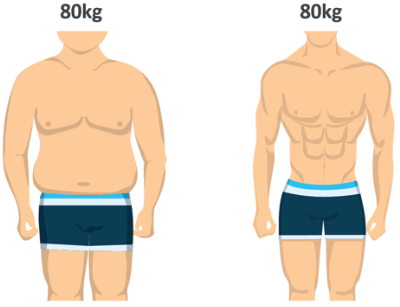A note on recomposition
So far, we have spoken largely about weight gain and loss, though of course we are not necessarily concerned only with weight, but of body composition. In this course, we will be using the definition of ‘body composition’ which is concerned with the amount of muscle you have compared to the amount of fat you have, though body composition strictly speaking is also concerned with other tissues and water etc. We will also assume that ‘improved’ body composition is achieved when muscle is increased and/or fat is lost.
Body recomposition is, therefore, a shift in the amount of fat and muscle you carry independent in changes of weight. In simple terms, recomposition is the process of building muscle tissue and losing fat tissue at the same time. To explain this process, we need to brush over some very basic physiology first.

Recall the cellular processes which were mentioned above as being constituents of metabolism. One of these was protein turnover, which is the process of combining amino acids which are in the bloodstream with the proteins in skeletal muscle (this is going to be covered a lot more in the next module). Muscle protein synthesis is the process by which muscle is built. It is also, however, the process by which muscle is maintained.
24 hours per day, proteins are being broken down and rebuilt within your muscle tissue (which is why it’s called turnover). This happens every single day, regardless of whether or not a person performs resistance training in order to keep the tissues and cells in proper working order. Rather than resistance training being the thing which allows this process to happen, it is more accurate to consider resistance training a process by which we allow for greater amounts of muscle protein synthesis to occur. To illustrate:
- On a normal day, you might break down 10 units of protein within your muscle and rebuild another 10, leaving a net of zero. If you perform resistance training you increase the amount of muscle protein synthesis which is possible over the next 72 hours or so, meaning that you have broken down 12 units of protein (more because of training) but could potentially rebuild 14 or 15, meaning a net of 2 or 3 increase
(These numbers are of course random just to illustrate a point and not relative to anything specific or proportionately accurate).
This process is an energy dependent one. Not only does dietary protein (or at least the constituent parts of it) need to be consumed so it can be stored within muscle tissue, you also need energy over and above what would usually be required to maintain that muscle to do it. That makes logical sense, because each unit of protein stored requires a certain amount of energy to facilitate that storage.
So, in order to gain muscle, the most simple manner is to eat more calories than you require to maintain your weight, but if you read the above, at no point does it say you need more energy than you need for weight maintenance, you just need more energy than is required for muscle protein maintenance.
If you are eating around the same amount of energy that you need during the day (so at maintenance level), but performing resistance training and eating protein in a manner which is in line with what is required for building muscle, it is VERY possible that your body’s fat stores can be accessed for energy which is then used in the muscle building process.
You are eating X amount of energy, but then adding Y amount of energy from your fat stores in order to facilitate muscle growth.
In short, if you are training in a progressive manner and eating at maintenance level with protein intake optimised, you can indeed maintain your weight, lose fat and build muscle at the same time.
Some considerations:
- Both muscle gain and fat loss will be slower than if you’d focused on one or the other by itself
- At some point, you will need to gain weight to gain large amounts of muscle. At some point, also, you will need to lose weight to get very lean. This may be beyond what some people in the general population, perhaps you included, care about, but if you are now 70kg and want to be 80kg and lean, you’re probably going to have to overshoot that by quite a bit at some point
- This requires more consistency and precision with your nutrition and training than doing one and then the other
- The process can be somewhat frustrating, as changes are not going to be as dramatic as if you did one or the other
- The more advanced in terms of muscular development and training age you are, the harder this is to do to a level which will give meaningfully noticeable results
With those considerations made, though, there are some positive things to be said about the recomposition option. Namely, you never have to ‘look fat’ or suffer with a low food intake, you will always fit your clothes nicely and, for those happy to wait a longer time for results, it’s comparatively less stressful as you need to more or less do the same thing all year round.
There is no right and wrong answer here, but from experience those for whom training is only a small part of their lifestyle, recomposition is a better option while for those who are seeking either faster or more dramatic results the lean gain/fat loss approach is more appropriate. As always, though, adherence is key and you need to decide the best approach for the situation.